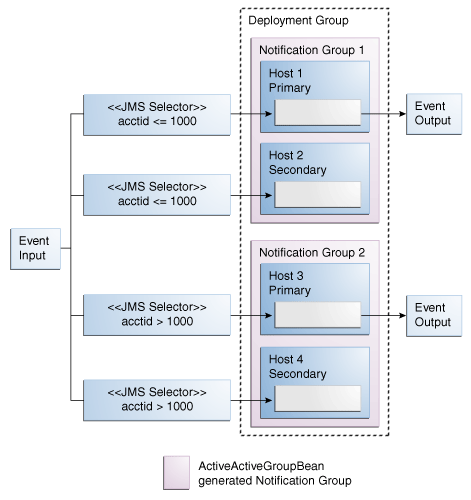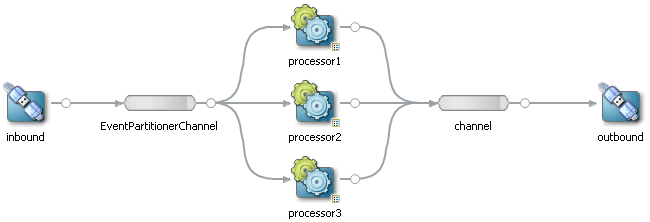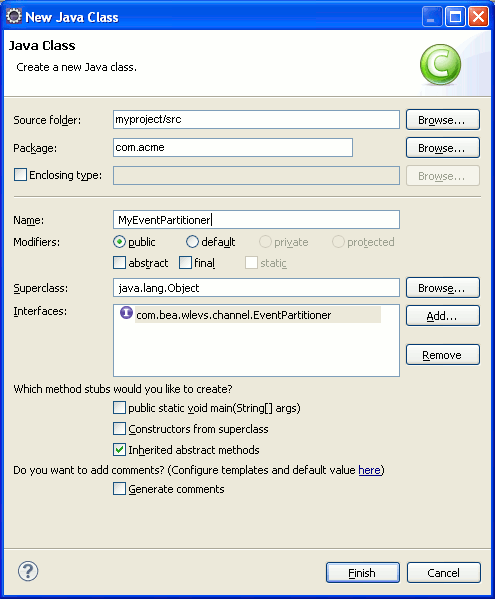23 Configuring Scalability
This chapter describes how to configure scalability for your Oracle Complex Event Processing (Oracle CEP) application, including information on setting up event partitioning.
-
Section 23.1, "Configuring Scalability With a Channel EventPartitioner"
-
Section 23.2, "Configuring Scalability With the ActiveActiveGroupBean"
For more information on scalability options, see Chapter 22, "Understanding Scalability".
23.1 Configuring Scalability With a Channel EventPartitioner
This section describes how to configure a channel with an Oracle CEP event partitioner as Figure 23-1 shows, including:
-
Section 23.1.1, "How to Configure Scalability With the Default Channel EventPartitioner"
-
Section 23.1.2, "How to Configure Scalability With a Custom Channel EventPartitioner"
In this example, assume that the inbound adapter is sending events of type PriceEvent, defined as Example 23-1 shows:
Example 23-1 Definition of Event Type PriceEvent
<wlevs:event-type-repository>
<wlevs:event-type type-name="PriceEvent">
<wlevs:properties>
<wlevs:property name="symbol" type="char" />
<wlevs:property name="price" type="long" />
</wlevs:properties>
</wlevs:event-type>
</wlevs:event-type-repository>
For more information, see Section 22.2.1, "EventPartitioner".
23.1.1 How to Configure Scalability With the Default Channel EventPartitioner
You can configure a channel to use the default event property-based event partitioner. Each time an incoming event arrives, the channel selects a listener and dispatches the event to that listener instead of broadcasting each event to every listener.
Optionally, you can implement your own EventPartitioner class to customize how the channel dispatches events to its listeners as Section 23.1.2, "How to Configure Scalability With a Custom Channel EventPartitioner" describes.
To configure scalability with the default channel EventPartitioner:
-
Add a channel to your EPN.
In Figure 23-1, the channel is
EventPartitionerChannel.For more information, see Chapter 9, "Configuring Channels".
-
Connect the channel to an upstream adapter.
In Figure 23-1, the upstream adapter is
inbound.For more information, see Section 6.4.2, "Connecting Nodes".
-
Connect the channel to two or more listeners.
In Figure 23-1, the channel is connected to Oracle CQL processors
processor1,processor2, andprocessor3.For more information, see Section 6.4.2, "Connecting Nodes"
-
Edit the EPN assembly file to add a
partitionByEventPropertyinstance property to the channel element.The
valueof thisinstance-propertyis the name of the event property by which the channel partitions events.In this example, the channel partitions events by event property
symbol.... <wlevs:channel id="EventPartitionerChannel" event-type="PriceEvent"> <wlevs:instance-property name="partitionByEventProperty" value="symbol" /> <wlevs:listener ref="processor1" /> <wlevs:listener ref="processor2" /> <wlevs:listener ref="processor3" /> <wlevs:source ref="inbound" /> </wlevs:channel> ...
For more information, see Section 22.2.1.1, "EventPartitioner Implementation".
-
Decide how you want Oracle CEP to allocate threads as Section 22.2.1.3, "EventPartitioner Threading" describes:
-
If you want the channel to allocate threads:
-
Edit the EPN assembly file to configure the channel to set
max-threadsto the number of listeners.... <wlevs:channel id="EventPartitionerChannel" event-type="PriceEvent" max-threads="3" > <wlevs:instance-property name="eventPartitioner" value="true" /> <wlevs:listener ref="processor1" /> <wlevs:listener ref="processor2" /> <wlevs:listener ref="processor3" /> <wlevs:source ref="inbound" /> </wlevs:channel> ...
-
-
If you want the upstream adapter to allocate threads:
-
Edit the EPN assembly file to configure the channel to set
max-threadsto 0.... <wlevs:channel id="EventPartitionerChannel" event-type="PriceEvent" max-threads="0" > <wlevs:instance-property name="eventPartitioner" value="true" /> <wlevs:listener ref="processor1" /> <wlevs:listener ref="processor2" /> <wlevs:listener ref="processor3" /> <wlevs:source ref="inbound" /> </wlevs:channel> ...
-
Edit the Oracle CEP server
config.xmlfile to add awork-managerelement.If this work manager is shared by more than one component (such as other adapters and Jetty), then set the
min-threads-constraintandmax-threads-constraintelements each to a value greater than the number of listeners.If this work manager is not shared by more than one component (that is, it is dedicated to the upstream adapter in this configuration), then set the
min-threads-constraintandmax-threads-constraintelements equal to the number of listeners.... <work-manager> <name>adapterWorkManager</name> <min-threads-constraint>3</min-threads-constraint> <max-threads-constraint>3</max-threads-constraint> </work-manager> ...For more information, see Section F.45, "work-manager".
-
Edit the component configuration file to configure the upstream adapter with this
work-manager.... <adapter> <name>inbound</name> <work-manager-name>adapterWorkManager</work-manager-name> ... </adapter> ...
-
-
-
Assemble and deploy your application.
For more information, see Chapter 24, "Assembling and Deploying Oracle CEP Applications".
At runtime, the channel uses the default event property-based
EventPartitionerto determine how to dispatch each incoming event to its listeners.
23.1.2 How to Configure Scalability With a Custom Channel EventPartitioner
You can implement your own EventPartitioner class to customize how a channel dispatches events to its listeners.
Optionally, you can use the default event property-based EventPartitioner as Section 23.1.1, "How to Configure Scalability With the Default Channel EventPartitioner" describes.
To configure scalability with a custom channel EventPartitioner:
-
Using the Oracle CEP IDE for Eclipse, open your Oracle CEP project.
For more information, see Section 4.2, "Creating Oracle CEP Projects".
-
Edit your
MANIFEST.MFto import packagecom.bea.wlevs.channel.For more information, see Section 4.7.5, "How to Import a Package".
-
Right-click your project's
srcfolder and select New > Class.The New Java Class dialog appears as Figure 23-2 shows.
-
Configure the New Java Class dialog as Table 23-1 describes.
Table 23-1 New Java Class Options for EventPartitioner
Option Description PackageEnter the class's package name.
NameEnter the class's name.
InterfacesClick Add and use the Implemented Interfaces Selection dialog to locate the
com.bea.wlevs.channel.EventPartitionerinterface, select it in the Matching Items list, and then click OK. -
Click Finish.
A new
EventPartitionerclass is created as Example 23-2 shows.Example 23-2 EventPartitioner Class
package com.acme; import com.bea.wlevs.channel.EventPartitioner; import com.bea.wlevs.ede.api.EventProcessingException; import com.bea.wlevs.ede.api.EventType; public class MyEventPartitioner implements EventPartitioner { @Override public void activateConfiguration(int arg0, EventType arg1) { // TODO Auto-generated method stub } @Override public int partition(Object arg0) throws EventProcessingException { // TODO Auto-generated method stub return 0; } } -
Complete the implementation of your
EventPartitioneras Example 23-3 shows.Example 23-3 EventPartitioner Class Implementation
package com.acme; import com.bea.wlevs.channel.EventPartitioner; import com.bea.wlevs.ede.api.EventProcessingException; import com.bea.wlevs.ede.api.EventType; public class MyEventPartitioner implements EventPartitioner { private final EventType eventType; private int numberOfPartitions; @Override public void activateConfiguration(int numberOfPartitions, EventType eventType) { this.numberOfPartitions = numberOfPartitions; this.eventType = eventType; } @Override public int partition(Object event) throws EventProcessingException { int dispatchToListener = 0; ... // Your implementation. return dispatchToListener; } }The
activateConfigurationmethod is a callback that the Oracle CEP server invokes beforeActivatableBean.afterConfigurationActiveand before yourEventPartitionerclass'spartitionmethod is invoked.When you associate this
EventPartitionerwith a channel, the channel will invoke yourEventPartitionerclass'spartitionmethod each time the channel receives an event.Your
partitionmethod must return the index of the listener to which the channel should dispatch the event. The index must be anintbetween0andnumberOfPartitions - 1. -
Add a channel to your EPN.
In Figure 23-1, the channel is
EventPartitionerChannel.For more information, see Chapter 9, "Configuring Channels".
-
Connect the channel to an upstream adapter.
In Figure 23-1, the upstream adapter is
inbound.For more information, see Section 6.4.2, "Connecting Nodes".
-
Connect the channel to two or more listeners.
In Figure 23-1, the channel is connected to Oracle CQL processors
processor1,processor2, andprocessor3.If you want to the channel to perform load balancing, each listener must be identical.
For more information, see:
-
Edit the EPN assembly file to add an
eventPartitionerinstance property to the channel element.The
valueof thisinstance-propertyis the fully qualified class name of theEventPartitionerinstance the channel will use to partition events.This class must be on your Oracle CEP application class path.
In this example, the channel uses
EventPartitionerinstancecom.acme.MyEventPartitionerto partition events.... <wlevs:channel id="EventPartitionerChannel" event-type="PriceEvent" max-threads="0" > <wlevs:instance-property name="eventPartitioner" value="com.acme.MyEventPartitioner" /> <wlevs:listener ref="filterFanoutProcessor1" /> <wlevs:listener ref="filterFanoutProcessor2" /> <wlevs:listener ref="filterFanoutProcessor3" /> <wlevs:source ref="PriceAdapter" /> </wlevs:channel> ... -
Decide how you want Oracle CEP to allocate threads as Section 22.2.1.3, "EventPartitioner Threading" describes:
-
If you want the channel to allocate threads:
-
Edit the EPN assembly file to configure the channel to set
max-threadsto the number of listeners.... <wlevs:channel id="EventPartitionerChannel" event-type="PriceEvent" max-threads="3" > <wlevs:instance-property name="eventPartitioner" value="true" /> <wlevs:listener ref="processor1" /> <wlevs:listener ref="processor2" /> <wlevs:listener ref="processor3" /> <wlevs:source ref="inbound" /> </wlevs:channel> ...
-
-
If you want the upstream adapter to allocate threads:
-
Edit the EPN assembly file to configure the channel to set
max-threadsto 0.... <wlevs:channel id="EventPartitionerChannel" event-type="PriceEvent" max-threads="0" > <wlevs:instance-property name="eventPartitioner" value="true" /> <wlevs:listener ref="processor1" /> <wlevs:listener ref="processor2" /> <wlevs:listener ref="processor3" /> <wlevs:source ref="inbound" /> </wlevs:channel> ... -
Edit the Oracle CEP server
config.xmlfile to add awork-managerelement.If this work manager is shared by more than one component (such as other adapters and Jetty), then set the
min-threads-constraintandmax-threads-constraintelements each to a value greater than the number of listeners.If this work manager is not shared by more than one component (that is, it is dedicated to the upstream adapter in this configuration), then set the
min-threads-constraintandmax-threads-constraintelements equal to the number of listeners.... <work-manager> <name>adapterWorkManager</name> <min-threads-constraint>3</min-threads-constraint> <max-threads-constraint>3</max-threads-constraint> </work-manager> ...For more information, see Section F.45, "work-manager".
-
Edit the component configuration file to configure the upstream adapter with this
work-manager.... <adapter> <name>inbound</name> <work-manager-name>adapterWorkManager</work-manager-name> ... </adapter> ...
-
-
-
Assemble and deploy your application.
For more information, see Chapter 24, "Assembling and Deploying Oracle CEP Applications".
At runtime, the channel uses your
EventPartitionerto determine how to dispatch each incoming event to its listeners.
23.2 Configuring Scalability With the ActiveActiveGroupBean
This section describes how to configure your Oracle CEP application to use the ActiveActiveGroupBean to partition an incoming JMS event stream by selector, including:
For more information, see Section 22.2.2, "ActiveActiveGroupBean".
23.2.1 How to Configure Scalability in a JMS Application Without Oracle CEP High Availability
You can use the ActiveActiveGroupBean to partition an incoming JMS event stream by selector in a multi-server domain for an application that does not use Oracle CEP high availability.
For information on how to use the ActiveActiveGroupBean in an Oracle CEP high availability application, see Section 23.2.2, "How to Configure Scalability in a JMS Application With Oracle CEP High Availability".
For more information, see Section 22.2.2.1, "Scalability in an Oracle CEP Application Using the ActiveActiveGroupBean Without High Availability".
To configure scalability in a JMS application without Oracle CEP high availability:
-
Create a multi-server domain.
For more information, see "Introduction to Multi-Server Domains" in the Oracle Fusion Middleware Administrator's Guide for Oracle Complex Event Processing.
In this example, the deployment group is named
MyDeploymentGroup. -
Configure the Oracle CEP server configuration file on each Oracle CEP server to add the appropriate
ActiveActiveGroupBeannotification group to thegroupschild element of theclusterelement.The Oracle CEP server configuration file,
config.xml, is located in theDOMAIN_DIR/servername/configdirectory, whereDOMAIN_DIRrefers to the main domain directory andservernamerefers to a particular server instance.For example, Table 23-3 shows
clusterelements for Oracle CEP serversocep-server-1,ocep-server-2,ocep-server-3, andocep-server-4. The deployment group isMyDeploymentGroupand notification groups are defined using defaultActiveActiveGroupBeannotification group naming.Optionally, you can specify your own group naming convention as Section 23.2.3, "How to Configure the ActiveActiveGroupBean Group Pattern Match" describes.
Table 23-2 Oracle CEP Server Configuration File groups Element Configuration
Partition cluster Element ocep-server-1<cluster> <server-name>ocep-server-1</server-name> ... <enabled>coherence</enabled> ... <groups>MyDeploymentGroup, ActiveActiveGroupBean_group1</groups> </cluster>ocep-server-2<cluster> <server-name>ocep-server-2</server-name> ... <enabled>coherence</enabled> ... <groups>MyDeploymentGroup, ActiveActiveGroupBean_group2</groups> </cluster>ocep-server-3<cluster> <server-name>ocep-server-3</server-name> ... <enabled>coherence</enabled> ... <groups>MyDeploymentGroup, ActiveActiveGroupBean_group3</groups> </cluster>ocep-server-4<cluster> <server-name>ocep-server-4</server-name> ... <enabled>coherence</enabled> ... <groups>MyDeploymentGroup, ActiveActiveGroupBean_group4</groups> </cluster> -
Create an Oracle CEP application.
-
Configure the EPN assembly file to add an
ActiveActiveGroupBeanelement as Example 23-8 shows. -
Define a parameterized
message-selectorin thejms-adapterelement for the JMS inbound adapters.Edit the component configuration file to add
group-bindingchild elements to thejms-adapterelement for the JMS inbound adapters.Add one
group-bindingelement for each possible JMS message-selector value as Example 23-10 shows.Example 23-5 jms-adapter Selector Definition for ocep-server-1
<jms-adapter> <name>JMSInboundAdapter</name> <event-type>StockTick</event-type> <jndi-provider-url>t3://ppurich-pc:7001</jndi-provider-url> <destination-jndi-name>./Topic1</destination-jndi-name> <user>weblogic</user> <password>weblogic1</password> <work-manager>JettyWorkManager</work-manager> <concurrent-consumers>1</concurrent-consumers> <session-transacted>true</session-transacted> <message-selector>${CONDITION}</message-selector> <bindings> <group-binding group-id="ActiveActiveGroupBean_group1"> <param id="CONDITION">acctid > 400</param> </group-binding> <group-binding group-id="ActiveActiveGroupBean_group2"> <param id="CONDITION">acctid BETWEEN 301 AND 400</param> </group-binding> <group-binding group-id="ActiveActiveGroupBean_group3"> <param id="CONDITION">acctid BETWEEN 201 AND 300</param> </group-binding> <group-binding group-id="ActiveActiveGroupBean_group4"> <param id="CONDITION">acctid <= 200</param> </group-binding> </bindings> </jms-adapter>In this configuration, when the application is deployed to an Oracle CEP server with a
clusterelementgroupschild element that containsActiveActiveGroupBean_group1, then theCONDITIONparameter is defined asacctid > 400and the application processes events whoseacctidproperty is greater than 400.Note:
Each in-bound JMS adapter must listen to a different topic.
For more information, see Chapter 7, "Configuring JMS Adapters".
-
Deploy your application to the deployment group of your multi-server domain.
For more information, see Chapter 24, "Assembling and Deploying Oracle CEP Applications".
At runtime, each Oracle CEP server configures its instance of the application with the
message-selectorthat corresponds to itsActiveActiveGroupBeannotification group. This partitions the JMS topic so that each instance of the application processes a subset of the total number of messages in parallel.
23.2.2 How to Configure Scalability in a JMS Application With Oracle CEP High Availability
You can use the ActiveActiveGroupBean to partition an incoming JMS event stream in a multi-server domain with Oracle CEP high availability.
This procedure uses the example application from Section 21.1.4, "How to Configure Precise Recovery With JMS", including the example EPN that Figure 23-3 shows, the corresponding EPN assembly file that Example 23-6 shows, and the corresponding component configuration file that Example 23-7 shows.
Figure 23-3 Precise Recovery With JMS EPN

Description of "Figure 23-3 Precise Recovery With JMS EPN"
Example 23-6 Precise Recovery With JMS EPN Assembly File
<?xml version="1.0" encoding="UTF-8"?>
<beans ... >
<wlevs:event-type-repository>
<wlevs:event-type type-name="StockTick">
<wlevs:properties>
<wlevs:property name="lastPrice" type="double" />
<wlevs:property name="symbol" type="char" />
</wlevs:properties>
</wlevs:event-type>
</wlevs:event-type-repository>
<wlevs:adapter id="JMSInboundAdapter" provider="jms-inbound">
<wlevs:listener ref="myHaInputAdapter"/>
</wlevs:adapter>
<wlevs:adapter id="myHaInputAdapter" provider="ha-inbound" >
<wlevs:instance-property name="keyProperties" value="sequenceNo"/>
<wlevs:instance-property name="timeProperty" value="inboundTime"/>
</wlevs:adapter>
<wlevs:channel id="channel1" event-type="StockTick">
<wlevs:listener ref="processor1" />
<wlevs:source ref="myHaInputAdapter"/>
<wlevs:application-timestamped>
<wlevs:expression>inboundTime</wlevs:expression>
</wlevs:application-timestamped>
</wlevs:channel>
<wlevs:processor id="processor1">
<wlevs:listener ref="channel2" />
</wlevs:processor>
<wlevs:channel id="channel2" event-type="StockTick">
<wlevs:listener ref="myHaCorrelatingAdapter" />
</wlevs:channel>
<wlevs:adapter id="myHaCorrelatingAdapter" provider="ha-correlating" >
<wlevs:instance-property name="correlatedSource" ref="clusterCorrelatingOutstream"/>
<wlevs:instance-property name="failOverDelay" value="2000"/>
<wlevs:listener ref="JMSOutboundAdapter"/>
</wlevs:adapter>
<wlevs:adapter id="JMSOutboundAdapter" provider="jms-outbound">
</wlevs:adapter>
<wlevs:adapter id="JMSInboundAdapter2" provider="jms-inbound">
</wlevs:adapter>
<wlevs:channel id="clusterCorrelatingOutstream" event-type="StockTick" advertise="true">
<wlevs:source ref="JMSInboundAdapter2"/>
</wlevs:channel>
</beans>
Example 23-7 Precise Recovery With JMS Component Configuration Assembly File
<?xml version="1.0" encoding="UTF-8"?>
<wlevs:config
xmlns:wlevs="http://www.bea.com/ns/wlevs/config/application"
xmlns:ha="http://www.oracle.com/ns/cep/config/cluster/">
<processor>
<name>processor1</name>
<rules>
<query id="helloworldRule">
<![CDATA[ select * from channel1 [Now] ]]>
</query>
</rules>
</processor>
<jms-adapter>
<name>JMSInboundAdapter</name>
<event-type>StockTick</event-type>
<jndi-provider-url>t3://ppurich-pc:7001</jndi-provider-url>
<destination-jndi-name>./Topic1</destination-jndi-name>
<session-transacted>true</session-transacted>
...
</jms-adapter>
<jms-adapter>
<name>JMSInboundAdapter2</name>
<event-type>StockTick</event-type>
<jndi-provider-url>t3://ppurich-pc:7001</jndi-provider-url>
<destination-jndi-name>./Topic2</destination-jndi-name>
<session-transacted>true</session-transacted>
...
</jms-adapter>
<jms-adapter>
<name>JMSOutboundAdapter</name>
<event-type>StockTick</event-type>
<jndi-provider-url>t3://ppurich-pc:7001</jndi-provider-url>
<destination-jndi-name>./Topic2</destination-jndi-name>
<session-transacted>true</session-transacted>
...
</jms-adapter>
</wlevs:config>
This procedure will create the Oracle CEP high availability configuration that Figure 23-4 shows.
Figure 23-4 Oracle CEP ActiveActiveGroupBean With High Availability

Description of "Figure 23-4 Oracle CEP ActiveActiveGroupBean With High Availability"
For more information, see Section 22.2.2.2, "Scalability in an Oracle CEP Application Using the ActiveActiveGroupBean With High Availability".
To configure scalability in a JMS application with Oracle CEP high availability:
-
Create a multi-server domain.
For more information, see "Introduction to Multi-Server Domains" in the Oracle Fusion Middleware Administrator's Guide for Oracle Complex Event Processing.
In this example, the deployment group is named
MyDeploymentGroup. -
Configure the Oracle CEP server configuration file on each Oracle CEP server to add the appropriate
ActiveActiveGroupBeannotification group to thegroupschild element of theclusterelement.The Oracle CEP server configuration file,
config.xml, is located in theDOMAIN_DIR/servername/configdirectory, whereDOMAIN_DIRrefers to the main domain directory andservernamerefers to a particular server instance.For example, Table 23-3 shows
clusterelements for Oracle CEP serversocep-server-1,ocep-server-2,ocep-server-3, andocep-server-4. The deployment group isMyDeploymentGroupand notification groups are defined using defaultActiveActiveGroupBeannotification group names.Note that
ocep-server-1andocep-server-2use the same notification group name (ActiveActiveGroupBean_group1) andocep-server-3andocep-server-4use the same notification group name (ActiveActiveGroupBean_group2).Optionally, you can specify your own group naming convention as Section 23.2.3, "How to Configure the ActiveActiveGroupBean Group Pattern Match" describes.
Table 23-3 Oracle CEP Server Configuration File groups Element Configuration
Partition cluster Element ocep-server-1<cluster> <server-name>ocep-server-1</server-name> ... <enabled>coherence</enabled> ... <groups>MyDeploymentGroup, ActiveActiveGroupBean_group1</groups> </cluster>ocep-server-2<cluster> <server-name>ocep-server-2</server-name> ... <enabled>coherence</enabled> ... <groups>MyDeploymentGroup, ActiveActiveGroupBean_group1</groups> </cluster>ocep-server-3<cluster> <server-name>ocep-server-3</server-name> ... <enabled>coherence</enabled> ... <groups>MyDeploymentGroup, ActiveActiveGroupBean_group2</groups> </cluster>ocep-server-4<cluster> <server-name>ocep-server-4</server-name> ... <enabled>coherence</enabled> ... <groups>MyDeploymentGroup, ActiveActiveGroupBean_group2</groups> </cluster> -
Create an Oracle CEP high availability application.
For more information, see Chapter 21, "Configuring High Availability".
-
Configure the EPN assembly file to add an
ActiveActiveGroupBeanelement as Example 23-8 shows. -
Edit the component configuration file to configure a jms-adapter element for the inbound JMS adapters as Example 23-9 shows:
-
Each in-bound JMS adapter must listen to a different topic.
-
Set
session-transactedtotrue.
Example 23-9 jms-adapter Element for Inbound JMS Adapters
<?xml version="1.0" encoding="UTF-8"?> <wlevs:config xmlns:wlevs="http://www.bea.com/ns/wlevs/config/application" xmlns:ha="http://www.oracle.com/ns/cep/config/cluster/"> ... <jms-adapter> <name>JMSInboundAdapter</name> <event-type>StockTick</event-type> <jndi-provider-url>t3://ppurich-pc:7001</jndi-provider-url> <destination-jndi-name>./Topic1</destination-jndi-name> <session-transacted>true</session-transacted> ... </jms-adapter> <jms-adapter> <name>JMSInboundAdapter2</name> <event-type>StockTick</event-type> <jndi-provider-url>t3://ppurich-pc:7001</jndi-provider-url> <destination-jndi-name>./Topic2</destination-jndi-name> <session-transacted>true</session-transacted> ... </jms-adapter> </wlevs:config>For more information, see Chapter 7, "Configuring JMS Adapters".
-
-
Define a parameterized
message-selectorin thejms-adapterelement for each JMS inbound adapter.Edit the component configuration file to add
group-bindingchild elements to thejms-adapterelement for the JMS inbound adapters.Add one
group-bindingelement for each possible JMSmessage-selectorvalue as Example 23-10 shows.Example 23-10 jms-adapter Selector Definition for ocep-server-1
<jms-adapter> <name>JMSInboundAdapter</name> <event-type>StockTick</event-type> <jndi-provider-url>t3://ppurich-pc:7001</jndi-provider-url> <destination-jndi-name>./Topic1</destination-jndi-name> <session-transacted>true</session-transacted> <message-selector>${CONDITION}</message-selector> <bindings> <group-binding group-id="ActiveActiveGroupBean_group1"> <param id="CONDITION">acctid <= 1000</param> </group-binding> <group-binding group-id="ActiveActiveGroupBean_group2"> <param id="CONDITION">acctid > 1000</param> </group-binding> </bindings> </jms-adapter>In this configuration, when the application is deployed to an Oracle CEP server with a
clusterelementgroupschild element that containsActiveActiveGroupBean_group1, then theCONDITIONparameter is defined asacctid <= 1000and the application processes events whoseacctidproperty is less than or equal to 1000. Similarly, when the application is deployed to an Oracle CEP server with aclusterelementgroupschild element that containsActiveActiveGroupBean_group2, then theCONDITIONparameter is defined asacctid > 1000and the application processes events whoseacctidproperty is greater than 1000. -
Edit the component configuration file to configure a
jms-adapterelement for the outbound JMS adapter as Example 23-11 shows:-
Configure the out-bound JMS adapter with the same topic as the correlating in-bound adapter (in this example,
JMSInboundAdapter2:./Topic2). -
Set
session-transactedtotrue.
Example 23-11 jms-adapter Element for Outbound JMS Adapters
<?xml version="1.0" encoding="UTF-8"?> <wlevs:config xmlns:wlevs="http://www.bea.com/ns/wlevs/config/application" xmlns:ha="http://www.oracle.com/ns/cep/config/cluster/"> ... <jms-adapter> <name>JMSInboundAdapter</name> <event-type>StockTick</event-type> <jndi-provider-url>t3://ppurich-pc:7001</jndi-provider-url> <destination-jndi-name>./Topic1</destination-jndi-name> <session-transacted>true</session-transacted> ... </jms-adapter> <jms-adapter> <name>JMSInboundAdapter2</name> <event-type>StockTick</event-type> <jndi-provider-url>t3://ppurich-pc:7001</jndi-provider-url> <destination-jndi-name>./Topic2</destination-jndi-name> <session-transacted>true</session-transacted> ... </jms-adapter> <jms-adapter> <name>JMSOutboundAdapter</name> <event-type>StockTick</event-type> <jndi-provider-url>t3://ppurich-pc:7001</jndi-provider-url> <destination-jndi-name>./Topic2</destination-jndi-name> <session-transacted>true</session-transacted> ... </jms-adapter> </wlevs:config>For more information, see Chapter 7, "Configuring JMS Adapters".
-
-
Deploy your application to the deployment group of your multi-server domain.
For more information, see Chapter 24, "Assembling and Deploying Oracle CEP Applications".
At runtime, each Oracle CEP server configures its instance of the application with the
message-selectorthat corresponds to itsActiveActiveGroupBeannotification group. This partitions the JMS topic so that each instance of the application processes a subset of the total number of messages in parallel.If the active Oracle CEP server in an
ActiveActiveGroupBeangroup goes down, the Oracle CEP server performs an Oracle CEP high availability failover to the standby Oracle CEP server in thatActiveActiveGroupBeangroup.
23.2.3 How to Configure the ActiveActiveGroupBean Group Pattern Match
By default, the ActiveActiveGroupBean creates notification groups named:
ActiveActiveGroupBean_X
Where X is a string.
At runtime, the ActiveActiveGroupBean scans the existing groups defined on the Oracle CEP server and applies a default pattern match of:
ActiveActiveGroupBean_\\w+
When it finds a match, it creates a notification group of that name.
Optionally, you can define your own group pattern to specify a different notification group naming pattern.
How to configure the ActiveActiveGroupBean group pattern match:
-
Configure the EPN assembly file to add a
groupPatternattribute to yourActiveActiveGroupBeanelement as Example 23-12 shows. -
Specify a value for the
groupPatternattribute that matches the cluster group naming convention you want to use for notification groups.

